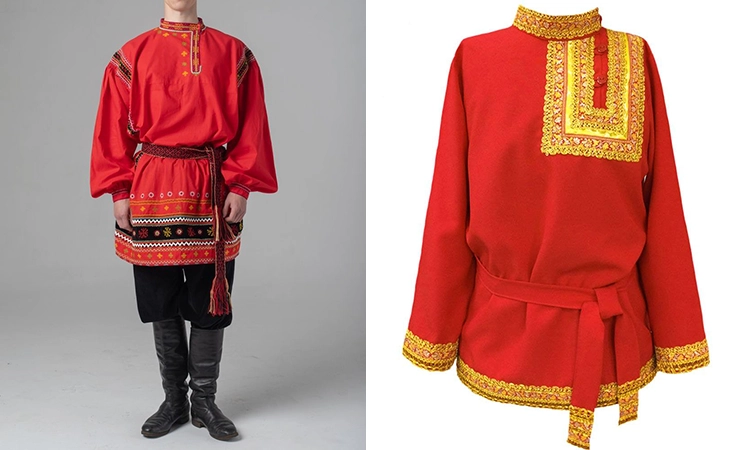Russia’s traditional clothing reflects centuries of history, climate, and culture, blending practicality with artistry. From fur-lined winter garments to elaborately embroidered dresses and headdresses, each piece carries symbolic meaning and showcases the craftsmanship of its time. Traditional Russian clothing not only protected people from harsh conditions but also expressed regional identity and social status. Below is a complete guide highlighting the most iconic pieces of men’s and women’s traditional attire in Russia.
Men’s Traditional Clothing in Russia
Kosovorotka

The kosovorotka is one of the most iconic garments in Russian men’s clothing, recognized by its distinctive asymmetrical collar. This long-sleeved shirt was typically worn untucked, belted at the waist with a sash, and decorated with embroidery around the neckline and cuffs. It was practical for everyday work yet also worn on festive occasions, with the richness of the fabric and decoration reflecting the wearer’s social standing. The kosovorotka became so deeply tied to Russian identity that it remains a symbol of folk tradition to this day.
Kaftan


The kaftan, a long coatlike garment, was worn over the kosovorotka and served as an essential part of men’s attire. Made from wool or heavy fabrics, it provided warmth during Russia’s cold seasons while allowing layering underneath. Wealthier men often had kaftans trimmed with fur or embroidered with gold thread, making them a marker of prestige. The garment’s versatility meant it was used across classes, from peasants to nobility, though the design and materials differed greatly.
Ushanka

The ushanka, a fur hat with ear flaps, is perhaps the most internationally recognized element of Russian clothing. Traditionally made from sheepskin, rabbit, or fox fur, it provided unmatched warmth during severe winters. The flaps could be tied under the chin, at the back of the head, or on top, making it adaptable to weather conditions. More than just practical, the ushanka has become a cultural symbol of Russian resilience and is still worn today in both traditional and modern variations.
Lapti

Lapti, traditional bast shoes woven from linden bark, were once the most common footwear among Russian peasants. Lightweight and simple to produce, they were an affordable solution for rural communities, though not suited for wet or snowy weather. Worn with footwraps or simple cloth, lapti were a symbol of peasant life and often associated with simplicity and humility. Despite being replaced by sturdier footwear over time, lapti remain a powerful folk symbol of traditional Russian village culture.
Valenki

Valenki, the famous felt boots, are another essential element of Russian men’s clothing. Made from tightly compressed sheep’s wool, they are designed to keep feet warm in extreme cold, often paired with galoshes to protect against snow and slush. Valenki were indispensable in rural life and became a timeless solution for Russia’s harsh winters. Even today, they are celebrated as a uniquely Russian invention, blending comfort, practicality, and tradition.
Women’s Traditional Clothing in Russia
Sarafan

The sarafan is the most recognizable garment in Russian women’s traditional attire, a long sleeveless dress typically worn over a blouse. Originating in the northern regions, it was popular among peasants and nobility alike, with variations in fabric and decoration distinguishing social status. Bright colors and embroidered patterns made sarafans festive and visually striking, turning them into a symbol of femininity and cultural pride. Today, sarafans are often showcased in folk performances and cultural celebrations.
Kokoshnik

The kokoshnik is the elaborate headdress that crowned traditional Russian women’s outfits, especially in festive and ceremonial contexts. Its shape and size varied by region, from tall and pointed to rounded styles, and it was often richly decorated with pearls, beads, and embroidery. Reserved for married women in many regions, the kokoshnik was more than just an accessory — it symbolized dignity, beauty, and status. The headdress became so iconic that it influenced court fashion and remains one of the most recognizable images of Russian heritage.
Poneva

The poneva is a woolen skirt traditionally worn by married women, often in checkered or striped patterns. It was wrapped around the waist and secured with a woven belt, signaling both practicality and cultural meaning. The poneva distinguished married women from unmarried ones, who typically wore sarafans instead. Its sturdy fabric made it suitable for rural life, while colorful patterns and belts added a festive touch.
Dushegreya

The dushegreya was a short, fitted vest worn over the rubakha or sarafan, serving both decorative and practical purposes. Often made from silk or brocade and padded for warmth, it emphasized the female silhouette while keeping the wearer comfortable. Wealthy women embellished their dushegreyas with embroidery, beads, or fur trims, making them ornate garments for celebrations. This piece highlighted the layering tradition in Russian dress, combining elegance with function.
Shuba

The shuba, a long fur coat, was indispensable in Russian women’s clothing, especially in winter. Made from sheepskin, sable, or fox fur, the shuba provided warmth while also signaling wealth and prestige when crafted from luxurious pelts. Women wore them over layered garments, often belted for shape and practicality. The shuba remains deeply tied to Russian identity, symbolizing both endurance in harsh climates and the artistry of traditional fur craftsmanship.
Modern Clothing in Russia

In modern Russia, traditional garments like the sarafan, kosovorotka, or kokoshnik are preserved mainly for cultural events, folk performances, and celebrations. However, their influence is still visible in contemporary fashion, where designers often reinterpret embroidery, patterns, and silhouettes for runway collections. Russian fashion today combines global trends with elements of national heritage, creating a unique blend of modern elegance and folk tradition. While practical clothing such as fur coats and valenki-inspired designs remain relevant, Russia’s fashion industry continues to expand internationally, showcasing its distinct style to the world.




